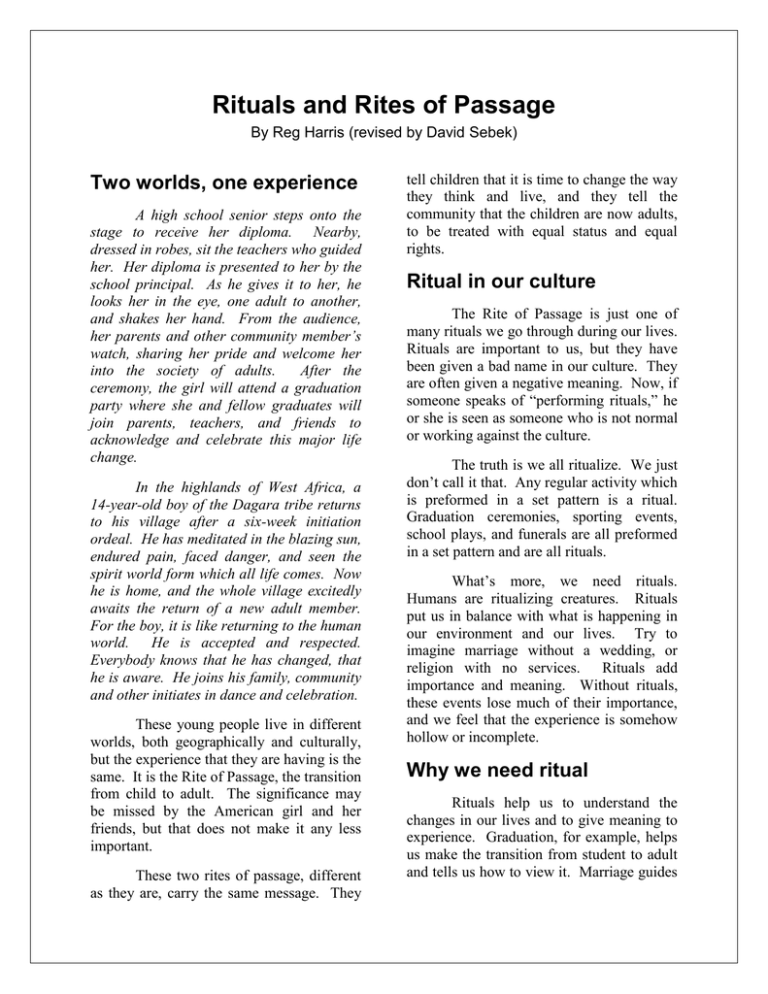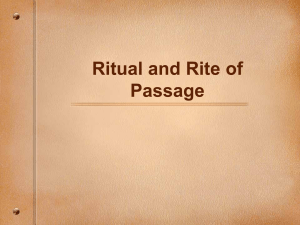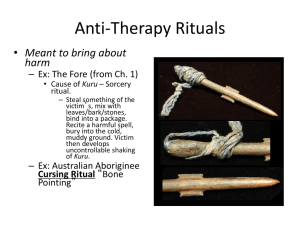Rituals and Rites of Passage: Cultural Analysis
advertisement

Rituals and Rites of Passage By Reg Harris (revised by David Sebek) Two worlds, one experience A high school senior steps onto the stage to receive her diploma. Nearby, dressed in robes, sit the teachers who guided her. Her diploma is presented to her by the school principal. As he gives it to her, he looks her in the eye, one adult to another, and shakes her hand. From the audience, her parents and other community member’s watch, sharing her pride and welcome her into the society of adults. After the ceremony, the girl will attend a graduation party where she and fellow graduates will join parents, teachers, and friends to acknowledge and celebrate this major life change. In the highlands of West Africa, a 14-year-old boy of the Dagara tribe returns to his village after a six-week initiation ordeal. He has meditated in the blazing sun, endured pain, faced danger, and seen the spirit world form which all life comes. Now he is home, and the whole village excitedly awaits the return of a new adult member. For the boy, it is like returning to the human world. He is accepted and respected. Everybody knows that he has changed, that he is aware. He joins his family, community and other initiates in dance and celebration. These young people live in different worlds, both geographically and culturally, but the experience that they are having is the same. It is the Rite of Passage, the transition from child to adult. The significance may be missed by the American girl and her friends, but that does not make it any less important. These two rites of passage, different as they are, carry the same message. They tell children that it is time to change the way they think and live, and they tell the community that the children are now adults, to be treated with equal status and equal rights. Ritual in our culture The Rite of Passage is just one of many rituals we go through during our lives. Rituals are important to us, but they have been given a bad name in our culture. They are often given a negative meaning. Now, if someone speaks of “performing rituals,” he or she is seen as someone who is not normal or working against the culture. The truth is we all ritualize. We just don’t call it that. Any regular activity which is preformed in a set pattern is a ritual. Graduation ceremonies, sporting events, school plays, and funerals are all preformed in a set pattern and are all rituals. What’s more, we need rituals. Humans are ritualizing creatures. Rituals put us in balance with what is happening in our environment and our lives. Try to imagine marriage without a wedding, or religion with no services. Rituals add importance and meaning. Without rituals, these events lose much of their importance, and we feel that the experience is somehow hollow or incomplete. Why we need ritual Rituals help us to understand the changes in our lives and to give meaning to experience. Graduation, for example, helps us make the transition from student to adult and tells us how to view it. Marriage guides from individual life to family life and prepares us for the changes we must make. Rituals also force the order we need to live in a shared world. We use ritual to standardize the way we relate to our environment and each other so that we can all get along and live together. To see this, imagine the process of earning your driver’s license in a few years. Like the Dagara boy in the example earlier, you will have to study, learn the signs, laws and procedures of the road. You will practice with a mentor (drive time), who helps you develop the skills you need. Then you will take the test to show that you can assume the responsibility of driving on your own. Finally, where the Dagara boy might be tattooed, you are fingerprinted and photographed for your license; this will confirm that you are initiated. In a way, earning a driver’s license is a ritual whereby society will “initiate” you into the order and state of mind we all must have if we will share the road safely. Every driver trusts that every other driver knows the code and will follow it. If not, the system collapses, cars would be wrecked and people hurt. Ritual helps us maintain the system. We all ritualize As pre-teens, you ritualize all the time. The way you greet your friends, behave at parties, or come into the school building every morning are all ritualized activities. For example, there is a style of dress and behavior that is appropriate for coming to school and another style for a day at the beach. The person who arrives at school in their swimsuit, flip-flops and tank top violates the ritualized standards for dressing for a day at school. There are countless other activities which have been ritualized. Decorating a Christmas tree is an annual ritual. The birthday party with its songs, games, cake and candles is a ritual. Even where you sit at the dinner table may be ritualized. Rituals are crucial to the functioning of our community structure, whether that structure is the single family or an entire community. The order, direction, and significance they give to our shared lives form the glue which holds us together. Without effective rituals, the patterns we need for relationships disappear and our sense of community – you and I sharing a common space and experience – vanishes. Rituals in native cultures In native cultures, the community provided the rituals. Families stayed together, and people worked in small, supportive groups. People were interdependent, not independent, because they relied on each other for support and survival. Everyone had to be part of the group, share the load, and work together or the group died. Because of this need, social roles were well-defined and the transitions between them were clearly marked with elaborate rituals. Birth, naming, passage into adulthood, marriage and death all demanded community rituals to help everyone understand and respect the transition. Rituals gave these changes meaning. They kept individuals and communities in harmony with the patterns of life. Rituals bonded one generation to another and were passed on as part of a group’s cultural and spiritual legacy. Unfortunately, our modern culture has diminished the value of ritual, which has created many problems. If the society doesn’t provide guiding rituals, we invent or find them ourselves. Much of the increase in gang activity and our obsessive fascination with sports can be traced to a search for ritual structure and meaning. The Rite of Passage For native cultures the most important ritual was the Rite of Passage. To insure survival, the tribe needed capable adults, so when a child could take on adult responsibilities, everyone rejoiced. Rites of Passage rituals marked the important transition from childhood to adulthood. Native peoples saw the Rite of Passage as a symbolic death and rebirth: the death of the child’s weak, dependent self and the rebirth of the strong, capable adult. The ritual told that child that he or she had to learn to think in a new way. To have the power and depth needed to make this difficult transition, the Rite of Passage had to be long, frightening and mysterious. For many tribes, this meant acting out symbolically the child’s death and rebirth: a mythical monster swallowed the child and spit out an adult, or a fearsome spirit killed the youth and afterwards brought him back to life as a new person. This process had three stages: 1. The separation, when the initiate is severed from everyday life; 2. The initiation/transformation, where the child’s mind is transformed and the child’s old self is destroyed so that the new adult self can emerge, and 3. The return, when the new adult is reunited with life, but as an adult member of the tribe, not a child The Separation In the separation, the child is dragged (sometimes literally) from his or home, family, and normal life to confront the “monster” of growth and change. This is a moment of great meaning to the family. The parents know that their child will “die” and become and adult in the tribe with adult status and roles. Physical and psychological separation are essential. The child must be fully absorbed by the ritual, so he or she has to be removed from all distractions. Separation also takes away the framework of the child’s old relationships and their support, that child self has to “die.” The Initiation/Transformation Once separated, the child undergoes a long and difficult process of initiation and transformation. This may take a few weeks to many months. In certain Australian Aborigine tribes, boys had to complete a “walkabout” to become men. They had to walk alone across the desert wilderness. They carried only a spear and the survival skills they had learned. The walkabout lasted several months, and there was only one requirement to pass: you must survive. If the boys lived through the walkabout, they were men; if not, well… During the transformation, the child “dies” as a dependent, selfish person and is “reborn” as a responsible adult member of the community. This psychological change is often marked by a physical change, such as tattooing. Sometimes psychological death and re-birth are acted out symbolically. In some Native American tribes, the child had to kneel before the chief. The chief told him that he was going to face a spirit who would strike him dead and then immediately restore him to life. As the chief, he became “animated” by the spirit and shook violently. Then the spirit/chief threw a stone at the child. When the child was hit, he fell, believing he was dead. Moments later, the chief would begin striking the “dead” boy, and the boy would “come back to life” as a new person, ready to assume adult responsibilities and help support the tribe. The Return After their initiation/transformation, the child, now turned adult, returns to their village. They have made the mental and emotional adjustments needed to take on the vital adult tasks of protecting and sustaining their society. In traditional cultures, the return was important for both the new adults and the community. The welcome secured the new adults in their new roles and told the village that they were now adults, entitled to the respect and rights of adulthood Benefits of Passage Although the Rite of Passage was painful and difficult, children were anxious to make it. An adult who had not been initiated was considered a “non-person,” unworthy of respect or recognition. Adulthood brought rights and privileges that were denied to children. In most cultures, the uninitiated could not marry or own property, nor were they allowed a voice in tribal affairs. The tribe, too, was anxious for the children to make the passage. Its existence depended on adults who could protect and provide for the group. The Rite of Passage, and the bestowing of the rights of adulthood, was an honor for the child and a time of celebration for the tribe. Take the journey Our culture no longer has formal Rites of Passage. Events which would normally be considered transitions into adulthood have lost their power and meaning. With no rituals to provide meaning, we must create meaning for ourselves. Understanding how the Rite of Passage puts us in harmony with our social and natural worlds can help us do that. Understanding our points of passage can help us make difficult transitions and keep us on the path to growth, discovery and understanding.



